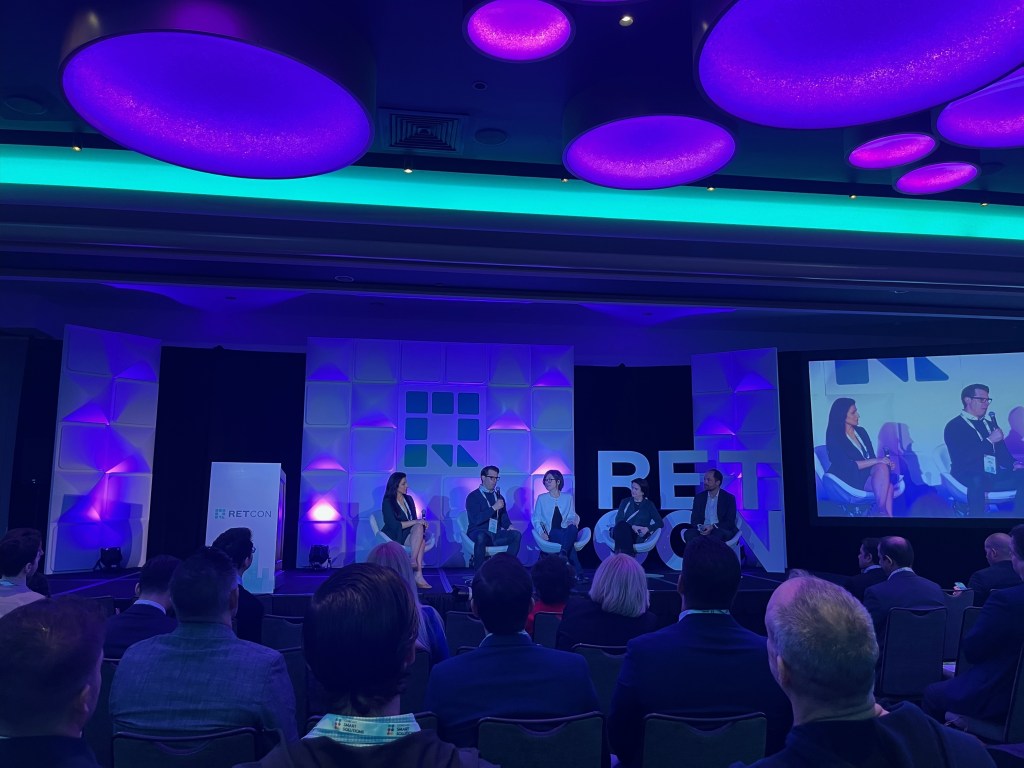RETCON 2024: Steady Progress in the Tech Stack

A recurring theme and sentiment on the first day of RETCON 2024 was that the commercial real estate industry, for a long time a slow adopter of new technologies, has caught up to many other business sectors. Much of this progress is owed to innovations in the realm of artificial intelligence, mindfulness towards employee and tenant feedback, as well as a more refined form of investment in tech startups.
For many panelists, what is equally important to which technologies to use in each tech stack are specific considerations around how they specifically can maximize returns for their assets, the tenants within them, as well as the employees using them.
As Nick Romito, CEO & co-founder of VTS, put it in a panel discussion, “The one thing we have gotten good at is the basics. We were 10 years behind every asset class, and now we have them down.”
Triumphs and challenges
But with this catch-up, however, comes a whole new set of considerations and challenges. Kicking off the conference was a discussion with Tal Kerret, president of Silverstein Properties. Demonstrating both how far the sector has come in the realm of innovation alongside the challenges it faces, Kerret highlighted his firm’s migration of employee badges to Apple’s Wallet application, giving employees wireless, contactless access to their office spaces owned and operated by Silverstein.
A conversation with Tal Kerret, president of Silverstein Properties. Photo by Gabriel Frank
Kerret then contrasted these innovations with increasing cybersecurity vulnerabilities and underscored the importance of staying vigilant against hacking attempts. “Almost all of our tenants were hacked at one point or another, and these problems become more severe as hackers get more sophisticated,” he recounted.
Silverstein president’s thoughts on artificial intelligence tell a similar story. Despite its widespread adoption and potential to assist with many tasks from the leasing process to HVAC maintenance, Kerret sees automation as both “overhyped and underhyped,” a tool for both good and bad. AI gives companies the potential to increase their number of employees utilizing the technology, but at the same time an overreliance on it might lead to reducing headcount.
Such sentiments were echoed in a subsequent panel, which combed through the thoughts of some high-profile owners and operators. Panelists made note of the sheer volume of data surrounding nearly every metric of a property that is now coupled with artificial intelligence capable of forming corelated actionable insights.
READ ALSO: Where Innovation Drives CRE Demand
But actually gleaning the insights themselves is easier said than done. Panelists agreed that without both approval from executive leadership and the employees utilizing the technology, most of them amount to meaningless numbers on a spreadsheet. “We are not great at turning data into insights,” reflected Luke Petherbridge, CEO of Link Logistics, as he noted the yawning gap between investment in data collection and analytics platforms without having the personnel on hand to make the most of them. “Not too many firms have data scientists,” he added.
For Petherbridge, solving these problems comes at the executive level. “You need the most senior people in your organization to say that data is important; if that starts rippling, everyone starts to focus on it throughout the firm,” the Link CEO explained.
Ultimately, investing in new technologies should aim at efficiency and simplicity for both owners and their tenants. “Tenants use multiple applications, and they have the same problems that we have,” Romito noted. “(The question is), how do we let the owner deliver to the tenant the tech that solves their own problems?”
The E in ESG: efficiency?
The answer to Romito’s question, and how it affects ESG initiatives, may lie in the way stakeholders talk to their building engineers, as well as to their tenants and business partners. Outside of regulations, the biggest incentives for stakeholders to implement all three tenets is a mix of secular investment trends, customer initiatives and the savings brought on by reduced energy usage, according to Yao Morin, chief technology officer at JLL. “In the next five years, there is going to be three times as much carbon-reduced office space supply,” in the same period where “200 of the Fortune 500 actually have carbon reduction goals,” Morin detailed.
READ ALSO: The Rapidly Rising Role of ESG
In practice, however, ESG initiatives actually demonstrate many of the technology-analytics discrepancies highlighted by Petherbridge and other panelists. From this perspective, “the S and G are dead,” according to Raul Velarde, director of project development at CP Group.
Even sensors and the digital twins they serve have their limitations, especially if operators cannot access data from the tenants’ suites. “Occupancy data (which determines decisions around HVAC usage and lighting) is a bit of a mess; it’s one of the most challenging things to try to collect,” explained Tom Arnold, CEO of Gridium.
Communication is key to solving these problems, be it through weekly email surveys to tenants occupying buildings where they pay the utilities, according to Arnold. “(They can) be an opportunity to save 10 to 20 grand a week; that kind of math gets people excited about lowering the utility bill.”
At the same time, it also works internally. “If you can’t look an engineer in the eye and say, if you have this tool and it will answer questions, you are not going to stick the landing unless you have support from the base of the account,” Arnold added.
Retail’s own tech boom
The tech strategies of several players in the retail sector demonstrate nearly all of the above trends, in both attracting and retaining tenants and boosting their own bottom lines.
The first similarity comes in the form of efficiency. In addition to using artificial intelligence to streamline the leasing process, the platforms also allow operators to select the right tenants and monitor, a boon given the sheer amount of competition for space, and the magnitude of revenue losses that sudden closures bring about. In using automation to select the right tenants and assist them with leasing and moving in, the end result is a faster, more “frictionless” process, according to Helane Stein, senior vice president & chief information officer at Brixmor Property Group.
Lee Jackson, senior vice president of digital solutions at JLL gets the latest retail proptech insights from Helane Stein of Brixmor Property Group and Talia Fine of Tanger. Photo by Gabriel Frank
But the tech integrations do not stop once a tenant moves in, however. Talia Fine, senior vice president of information technology at Tanger Outlets, sees a unique potential in using it to attract customers to the stores themselves. “For a loyalty program, you can market and cater to customers to give them a personalized shopping experience,” Fine explained.
Furthermore, Fine and Stein both take Petherbridge’s advice, particular where cyber hygiene is concerned. “We feel that the best line of defense is our employees,” Fine concluded.
The post RETCON 2024: Steady Progress in the Tech Stack appeared first on Commercial Property Executive.





